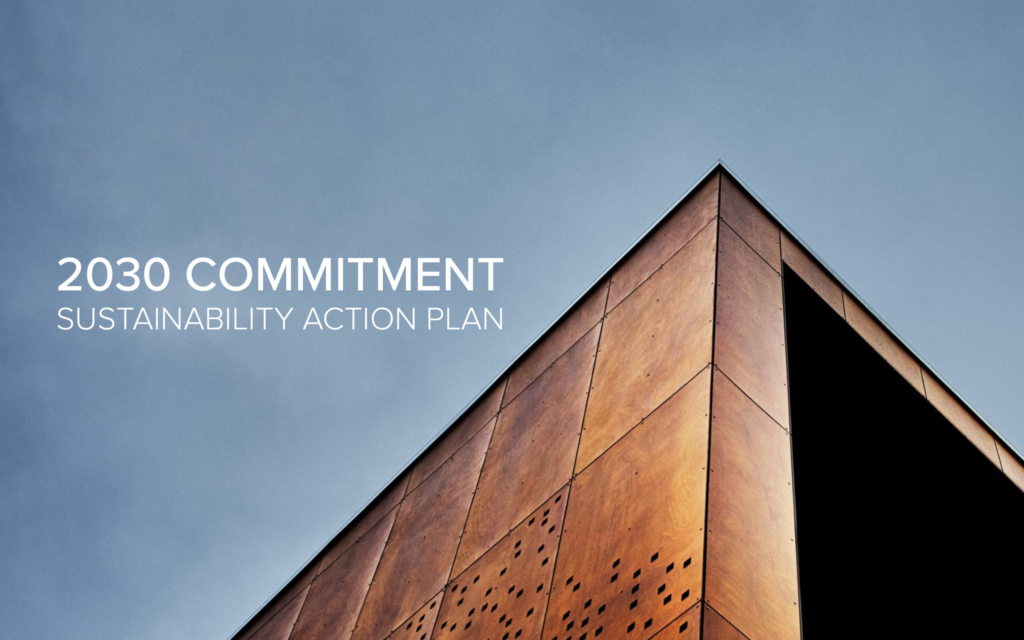
SNHA takes on the 2030 Commitment
In 2019, SNHA became signatories of the 2030 Commitment, formalizing our support of the 2030 Challenge and its goal of carbon neutrality for all new buildings and major renovations by 2030. As a first step, we put together a core AIA 2030 Commitment team, the members of which have been the primary leaders in pulling together the necessary materials and workflows as required for the commitment — primarily, the firm specific Sustainable Action Plan (or SAP) and reporting projects’ energy use intensity (or EUI) annually to the AIA DDx reporting system.
As it has been almost exactly two years since signing on to the 2030 Commitment and beginning efforts in these two realms, we thought we would take a moment to check in with the core team members — specifically asking why the 2030 Commitment is important, and how they see the 2030 Commitment changing the architecture of the future.
The first core team member who responded was architect, Jenna Staff, AIA, LEED AP BD+C, WELL AP (JS). Jenna has primarily worked on preparing the DDx reporting workflow for SNHA’s data center projects alongside architect, Josh Rau, AIA, LEED AP BD+C, and SNHA’s digital applications and data analytics specialist, Moses Scott. Together, the team has worked with in-house project teams to start reporting project EUI values for the 2020 reporting cycle. They have primarily worked on coordinating SNHA’s workflow with the energy analysis software, Cove.tool, but have also begun branching into other methods of energy analysis as well as researching data center performance for better baseline comparison and EUI targeting.
Q: How will the 2030 Commitment change the future of architecture?
JS: “I used to think the future of architecture was perhaps cities like the Jetsons, with flying cars and robots everywhere and sleek shiny, new high-rises. But as I learn more about sustainable design, I think our role as architects is going to be more about incorporating the inevitable advances in technology (sustainable and everything else) into the existing fabric of our cities,” says Jenna. “So, maybe we’ll have flying cars, but I think the brand new energy-intense high-rise office building is long overdue for a paradigm shift, and that we should focus instead on incorporating energy efficient strategies into the existing infrastructure we have.
As for rural-America — of which I am born and raised — houses keep getting bigger and made cheaper. The small country farmhouse — at least in Wisconsin — is often knocked down and replaced or simply left in neglect while a new 2-3,000 square-foot single family home complete with three car garage and wrap around deck is built in its place. Why? For the stuff that needs to go in them. Small 1,000 – 1,500 SF farmhouses don’t hold much because they used to not have that much. Just kids. And they shared rooms along with toys. Now, so much of what a country home is is wasted space and wasted materials to make that space for a much smaller number of people.”
To put this into perspective, in 1973, the average size of a newly constructed single-family home in the U.S. measured 1,660 square feet. In 2020, the census reported that average had increased to 2,333 square-feet, an increase of over 60%. The environmental impact of this increase seen in the form of lost green space and biodiversity and an increase in air pollution and energy consumption.
“Of course, this excess is more about the material-based lifestyle and single-use/throwaway culture, which for us architects, means the challenge is double fold,” says Jenna. “Just like anyone, clients want more for less and sometimes don’t necessarily think about the long-term effects of choosing the less-green but cheaper material. This is where architects can step in and direct the conversation to the better product or better design, but I think real change to the building industry is going to have be in the form of public policy and code amendments, and that architects are going to have to earnestly lobby for those changes both in practice and to the folks writing the rules.”
Our second core team responder was SNHA’s digital applications and data analytics specialist, Moses Scott (MS), who offered his perspective from a technology standpoint. With building’s long-term performances being determined early on by decisions made during the design and construction phases, Moses emphasizes the vital role software manufacturers play in being able to achieve better, more sustainable building standards.
Q: Why is the 2030 Commitment important to you/the building industry?
MS: “Out of immediate environmental necessity, this performance criteria now includes energy use, social equity concerns, and carbon footprints,” says Moses. “Traditional design and construction delivery methods had no means to capture and retain these additional types of performance metrics; and this reality is reflected in case studies that show up to 30% of data created during design and construction is lost by project close-out.”
Moses explains how the influence of the 2030 Commitment can help reduce this data loss from happening.
“It helps put economic pressure on AEC software manufacturers to address the data loss happening in the building industry when it comes to energy use and sustainability,” says Moses. “Currently, popular AEC software manufacturers have created analysis tools that are often at odds with the schedules, methodologies, and resources of those various participants. As opposed to letting the software manufactures dictate how the various participants contribute and participate, the industry must move towards an open-source standard that optimizes collaboration and feedback for both large and small participants.”
With technology as a major tool at our disposal, it seems reasonable to believe we will begin seeing that data created during the design and construction phases start being captured in digital threads that are optimized for change management, and able to incorporate information concerning energy use, carbon footprint, and other operational goals.
The other major tool is us — and the intrinsic motivations fueling each of our personal commitments to being a part of the solution. Connie Bank, AIA, LEED AP BD+C, WELL AP, is an AIA 2030 SNHA core team member working to holistically extend sustainability practices within the firm and her projects.
“It’s important to me personally to more fully understand what I am responsible for professionally,” says Connie, “This includes the effects on the communities and environments both within and downstream from the projects I work on and the products I specify.”
Regarding the standard that lays ahead for the next generations of designers and builders, Connie continues, “There’s a word that I haven’t yet found, but it’s the outcome when we sync with the planet, ourselves, and each other — and it’s that behavior that directs how we consider building.”
As we move toward 2030 and beyond, the SNHA core 2030 team continues to focus these thoughts into purposeful action via goals established as a part of the Sustainability Action Plan and through continued work to track and reduce energy use intensity across SNHA’s projects. We are excited about their potential to push ourselves, our design partners, and our clients to improve upon past successes, look for new opportunities, and grow as leaders in sustainability and the 2030 Commitment.
To learn more about the 2030 Commitment, check out the AIA website.
For a look at SNHA’s firm goals, you can download the Sustainability Action Plan book here.
